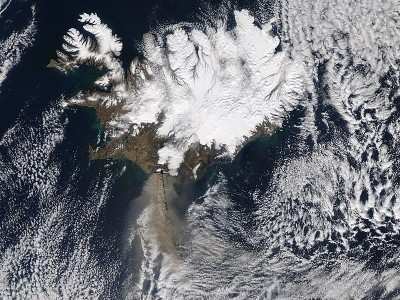Sat, Apr 24, 2010
SAIB Published With Guidelines, But Does Not Recommend Flight
Into Visible Ash
 The FAA this week published an SAIB (Special Airworthiness
Information Bulletin) addressing concerns about the operation of
aircraft with turbine engines into areas where volcanic ash is
present. The SAIB is specifically directed toward operators that
operate in Europe or operate in and out of Europe, while the
Icelandic volcano, Mount Eyjafjallajokull, is still active.
The FAA this week published an SAIB (Special Airworthiness
Information Bulletin) addressing concerns about the operation of
aircraft with turbine engines into areas where volcanic ash is
present. The SAIB is specifically directed toward operators that
operate in Europe or operate in and out of Europe, while the
Icelandic volcano, Mount Eyjafjallajokull, is still active.
After Mount Eyjafjallajokull ended almost 200 years of dormancy
with an eruption on March 20, EUROCONTROL shut down airspace
throughout various airports in Europe as a result of the drifting
volcanic ash cloud from the eruption On April 14. Since that
initial shutdown, the UK CAA has led a coordinated effort that
included the FAA. The effort identified an acceptable level of
dissipating ash concentration which has subsequently allowed
EUROCONTROL to allow flights to resume in most regions.
Volcanic ash can pose a significant threat to aviation safety.
During the 1980s, a number of flights into volcanic ash clouds
occurred that resulted in the simultaneous shutdown of all engines.
Volcanic ash can present short-term as well as long-term
operational hazards to turbine engines. While the shortterm affects
of erosion and power loss are well documented, the long-term
effects of repeated exposures are not well understood.
The SAIB provides information and recommends that operators
follow all new and existing Maintenance and Operational
Instructions from the respective aircraft and engine manufacturers
(Type Certificate Holders) including any recommended post-flight
checks on aircraft that might have flown through airspace
contaminated with volcanic ash. The European Aviation Safety Agency
(EASA) is issuing a Safety Information Bulletin on operations in
and around volcanic ash.

Before flying from the United States to Europe or within Europe,
aircraft owners and operators should review the following
recommendations:
- Although the FAA does not recommend engine operation or flight
into a visible volcanic ash cloud, we do recommend that you obtain
definitive information on operational limitations around ash
clouds, if any, from each of the European National Authority of the
State(s), of which you plan flight operations.
- Follow all aircraft and engine manufacturer’s operating
and maintenance instructions pertaining to operations in airspace
where volcanic ash may be near or present.
- Report any inadvertent encounter with volcanic ash or relevant
findings, including abnormal engine behavior, to the respective
type certificate holders of the aircraft and engines.
More News
Aero Linx: Model Aeronautical Association of Australia MAAA clubs are about fun flying, camaraderie and community. For over 75 years, the MAAA has been Australia’s largest fl>[...]
Touchdown Zone Lighting Two rows of transverse light bars located symmetrically about the runway centerline normally at 100 foot intervals. The basic system extends 3,000 feet alon>[...]
“Discovery and innovation are central to our mission at Virgin Galactic. We’re excited to build on our successful record of facilitating scientific experiments in subor>[...]
How To Get A Story On Aero-TV News/Feature Programming How do I submit a story idea or lead to Aero-TV? If you would like to submit a story idea or lead, please contact Jim Campbel>[...]
Student Pilot Reported That During Rotation, “All Of A Sudden The Back Of The Plane Kicked To The Right..." Analysis: The student pilot reported that during rotation, “>[...]
 ANN's Daily Aero-Linx (05.02.24)
ANN's Daily Aero-Linx (05.02.24) ANN's Daily Aero-Term (05.02.24): Touchdown Zone Lighting
ANN's Daily Aero-Term (05.02.24): Touchdown Zone Lighting Aero-News: Quote of the Day (05.02.24)
Aero-News: Quote of the Day (05.02.24) ANN FAQ: Contributing To Aero-TV
ANN FAQ: Contributing To Aero-TV NTSB Final Report: Cirrus Design Corp SR20
NTSB Final Report: Cirrus Design Corp SR20




